 |
60. Exploring My New Home (To Be)
“Wynford, what happened to your beard?” Wynford is a stick of a man employed by the management to keep David Morgan Apartments’ halls clean. I don’t yet know everybody by name, but I have struck up a friendship with Wynford, although I almost didn’t recognize him. His beard was long and white. He looked like an old scholar. He had shaved off his beard to raise money for a charitable cause, Marie Curie Hospice in Penarth. With the beard gone he looked younger, a man with cheeks like a baby’s bottom, less the scholar and more the face of a cherub. It was in this cherub guise that he gave me a short tour of the basement, a system of wide and brightly lit corridors that zigzagged the length and breadth of what was once the David Morgan Department Store.
There was Mr Khachaturian, a short, stout gentleman who patrols the halls and arcades of the David Morgan building seeing to our wellbeing, that we are safe and comfortable. We greet each other and talk. Talking is what the Welsh do, eager to know your story and have you know theirs. Neither Mr Khachaturian nor I is Welsh, but we are happy here, are made to feel we belong. He asked about my ongoing concerns with immigrating to the United Kingdom and told me the story of his difficulty bringing his wife from Armenia. “Make sure you do the paperwork correctly,” he warns. I assured him I have entrusted those complications to a solicitor.
I am in Wales because of Ms Keogh, my cherished companion, my homeland, my wife of twenty-nine years, as anyone who has read these essays will know. She wanted to come home to Britain and I have accompanied her. Now it is a matter of getting permission from the United Kingdom for me to stay here with her. I find myself pretty much sharing this story with everyone who enquires about my accent.

Everyone has a story to share, nor are the Welsh too polite to discuss politics or religion. Last Tuesday, Ms Keogh and I had dinner at Café Jazz, where you can usually find me on a Tuesday night listening to “jazz and swing in the traditional styles of the ’20s and ’30s.” Joe, the chef, does a terrific job with duck. At the next table was a gentleman who engaged us in conversation, so we invited him to our table making it easier to hear. He was a retired Anglican minister from Aberystwyth in town for the cricket matches and I was his first Peripatetic Minister of Secular Humanism, or, in other words, an Atheist. He stayed at our table until it was time to leave and we had a jolly good conversation. We talked about the dangers of Donald Trump and Nigel Farage, we compared our families, and we commiserated about the sad decline in churches and pubs.
An old friend living in Alaska, with whom I have not had much communication for many years, unexpectedly emailed me. He asked, “How are you adjusting to life as an expat?” I responded that there has been no adjusting. It has been a natural fit. If I didn’t have to return to the United States, I would just as soon not bother. I have never been happier about where I was living. During the day there is the bustling noise of activity from the swirling froth of pedestrian traffic on the Hayes. It is my white noise, the turbulence of downtown Cardiff, the reassurance of a thriving humanity, a city’s living pulse.

The Hayes
It’s not perfect. Young people take to the Hayes all night long. Least annoying are the skateboarders practicing, with crashing failures that erupt in applause or laughter, then cheers to try again. The older youth patrol the Hayes with their exuberance of unfettered freedom as they explode with enthusiasm for celebrating everything, a loud, tasteless, showiness that can go on past three o’clock in the morning. Or else it is the vituperative drama of discontented lovelorn youth performed in shouts of drunken “fuck, fuck, fuck!” It is the price paid for living in the heart of this capital city and college town. On weekends, two rock buskers blast their electric guitars just across the Hayes from our windows going on sometimes until sunrise. They get crowds of drunks, who are on the make fulfilling demanding hormones, to collect and sing the only two ruckus songs this rock duo know how to play. Ms Keogh and I pray for rainy nights. It is worse a block over on Saint Mary Street. Yet, as disruptive as the cacophony can be to our senses, I have walked among this disorderly nightlife never feeling threatened or unsafe.
The noise at night is not a full-hearted complaint because our bedroom has double glazed windows. We hear nothing when sleeping. Then, in the mornings, we can open our windows to the earliest buskers who play melodies sweet and soothing, whether it is Sam Hickman with her dulcet voice accompanying herself on harp, or a mellifluous aubade from Steve Fiorentini’s jazz guitar.

St John's Church, as it was in 1865.
Recently good fortune befell me. The bell tower at Saint John the Baptist Church, our neighbor, was opened to visitors. Of course I couldn’t miss the chance, paid my two pounds and climbed the spiral stone staircase. It was narrow, the steps too shallow near the axis to be of any use. Only one individual could pass at a time and my rucksack, filled with books, scraped the wall. The steps looped round and round, had me cursing my old knees and lungs that were out of practice, but I reached the ringing chamber. Ropes descended from holes in the ceiling for ten tuned bells. It takes ten tollers to operate the bells of Saint John the Baptist, although they can manage with six. I was able to inveigle an invitation from the ringing captain to come back for their Thursday night rehearsal.

The spiral staircase at St. John's.
My adventure was not over as the climb was not completed. I continued to climb the turret. The tower’s clock mechanism was concealed behind a locked door, but the bell chamber, inaccessible behind a gate, was nevertheless visible. I stood there awhile, hoping no one would try to pass me in that perilous spiral, studying the placement of ropes, the designs of the headstocks, and was eventually rewarded with seeing the bells move on their wheels. It was good and loud.
I had made it to the very top, to the openwork battlements over a hundred feet above the street. I stood on lead sheets hammered over the wooden roof of the church tower and viewed the city. A friendly agent of the church pointed to where the Taff River once flowed and where there had been quays in the city’s heart.
At the highest point of the church was the bright golden cockerel. The golden cockerel vane is a common sight on churches. I figure they use it because it is the symbol of Peter, though it seems an odd choice: a reminder that before the cockerel crowed Peter would disavow Jesus three times.
Then it was on to the Troutmark bookshop to trade in the books in my rucksack. I came away from Troutmark with a very clean copy of Daily Life in Ancient Rome by Jérôme Carcopino, the Folio Society edition. Two thousand years from now, will someone be mining my Snakeskin columns to gain insights into the Daily Life in Ancient Cardiff? I’m not so vain as to believe it, yet I do believe I have come into Cardiff for its golden age. The remains of a Roman fort form part of Cardiff Castle’s walls. Caerdydd has a long history and I have arrived following a decline of its famous steel industry and the export of coal, yet I think this city, since the building of the barrage, has entered a golden age of culture, education, and public service. I want to be a part of it.
![]()
Mr Bentzman will continue to report here regularly about
the events and concerns of his life. If you've any
comments or suggestions, he would be pleased to hear
from you.
Selected Suburban Soliloquies, the best of Mr Bentzman's earlier series of Snakeskin essays, is available as a book or as an ebook, from Amazon and elsewhere.
